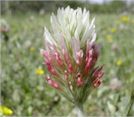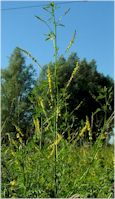 |
 |
In this country we possess about twenty species of the trefoil, or Clover, which is a plant so well known in its general features by its abundance in every field and on every grass plot, as not to need any detailed description. The special variety endowed with medicinal and curative virtues, is the Meadow Clover (Trifolium pratense), or red clover, called by some, Cocksheads, and familiar to children as Suckles, or Honey-suckles, because of the abundant nectar in the
long tubes of its corollae. Other names for it are Bee-bread, and Smere. An extract of this red clover is now confidently said to have the power of healing scrofulous sores, and of curing cancer. The New York Tribune of September, 1884, related a case of indisputable cancer of the breast of six years' standing, with an open fetid sore, which had penetrated the chest-wall between the ribs, and which was radically healed by a prolonged internal use of the extract of red
clover. Four years afterwards, in September, 1888, "the breast was found to be restored to its normal condition, all but a small place the size of half a dollar, which will in every probability become absorbed like the rest, so that the patient is considered by her physicians to be absolutely cured."
The likelihood is that whatever virtue the red clover can boast for counteracting a scrofulous disposition, and as antidotal to cancer, resides in its highly-elaborated lime, silica, and other earthy salts. Moreover, this experience is not new. Sir Spencer Wells, twenty years ago, recorded some cases of confirmed cancer cured by taking powdered and triturated oyster shells; whilst egg shells similarly reduced to a fine dust have proved equally efficacious. It is remarkable
that if the moorlands in the North of England, and in some parts of Ireland, are turned up for the first time, and strewed with lime, white clover springs up there in abundance.
Again, a syrup is made from the flowers of the red clover, which has a trustworthy reputation for curing whooping-cough, and of which a teaspoonful may be taken three or four times in the day. Also stress is laid on the healing of skin eruptions in children, by a decoction of the purple and white meadow trefoils.
The word clover is a corruption of the Latin clava a club; and the "clubs" on our playing cards are representations of clover leaves; whilst in France the same black suit is called trefle.
A conventional trefoil is figured on our coins, both Irish and English, this plant being the National Badge of Ireland. Its charm has been ever supposed there as an unfailing protection against evil influences, as is attested by the spray in the workman's cap, and in the bosom of the cotter's wife.
The clover trefoil is in some measure a sensitive plant; "its leaves," said Pliny, "do start up as if afraid of an assault when tempestuous weather is at hand."
The phrase, "living in clover," alludes to cattle being put to feed in rich pasturage.
A sworn foe to the purple clover cultivated by farmers, is the Dodder (Cuscuta trifolii), a destructive vegetable parasite which strangles the plants in a crafty fashion, and which goes by the name of "hellweed," or "devil's guts." It lies in ambush like a pigmy field octopus, with deadly suckers for draining the sap of its victims. These it mats together in its wiry, sinuous coils, and chokes relentlessly by the acre. Nevertheless, the petty garotter like a toad,
"ugly and venomous, wears yet a precious jewel in its head." "If boiled," says Hill, "with a little ginger, the dodder in decoction works briskly as a purge. Also, the thievish herb, when bruised and applied externally to scrofulous tumors, is an excellent remedy."
The word "dodder" signifies the plural of "dodd," a bunch of threads. The parasite is sometimes called "Red tangle" and "Lady's laces."
Its botanical name Cuscuta comes from the Greek Kassuo to sew together. If the piece of land infested with it is closely mown (and the cut material carried away unshaken), being next covered with deal saw-dust, on which a ten per cent. solution of sulphate of iron is freely poured, then by combining with the tannin contained in the stems of the Dodder, this will serve to kill the parasite without doing any injury to the clover or lucerne. Although a parasite the
plant springs every year from seed. It is a remedy for swooning or fainting fits.
 |
The Sweet Clover (or yellow Melilot), when prepared as a tincture (H.), with spirit of wine, and given as a medicine in material doses, causes, in sensitive persons, a severe headache, sometimes with a determination of blood to the head, and bleeding from the nose. When administered, on the principle of curative affinity, in much smaller doses, it is singularly beneficial against nervous headaches, with
oppression of the brain, acting helpfully within five minutes. Dr. Hughes (Brighton) writes: "I value this medicine much in nervous headaches, and I always carry it in my pocket-case as the mother tincture which I generally administer by olfaction." For epilepsy, it is said in the United States of America to be "the one grand master-remedy," by giving a drop of the tincture every five minutes during the attack, and
five drops five times a day in water, for some weeks |
afterwards.
The Melilot (from mel, honey, and lotus, because much liked by bees) is known as Plaster Clover from its use since Galen's time in plasters for dispersing tumors. Continental physicians still employ the same made of melilot, wax, resin, and olive oil. The plant contains, "Coumarin" in common with the Sweet Woodruff, and the Tonquin Bean. Other names for it are "Harts' Clover," because deer delight to feed on it and "King's Clover" or "Corona Regis," because "the
yellow flowers doe crown the top of the stalks as with a chaplet of gold." It is an herbaceous plant common in waste places, and having light green leaves; when dried it smells like Woodruff, or new hay.
Herb Simples
The Primitive Simplers presented here show the way of life in other generations, it is not suggested or recommended trying them yourself. |
|
Garden
Herbs
Home
History of Herbs
Herb Gardening
Herbs for Beginners
Drying & Preserving Herbs
Indoor Herb Gardening
Herb Garden
Hints & Tips
Herbal
Cooking
Herb Chart
Using Herbs
Culinary Herbs
Herb
Oil and Vinegar
Herb Teas
Herb Candy
Herb Jelly
Herb Simples
Preface
Introduction
Alphabetical Listing

Trade
Recipes Online
Share your Recipes with others!!
|




